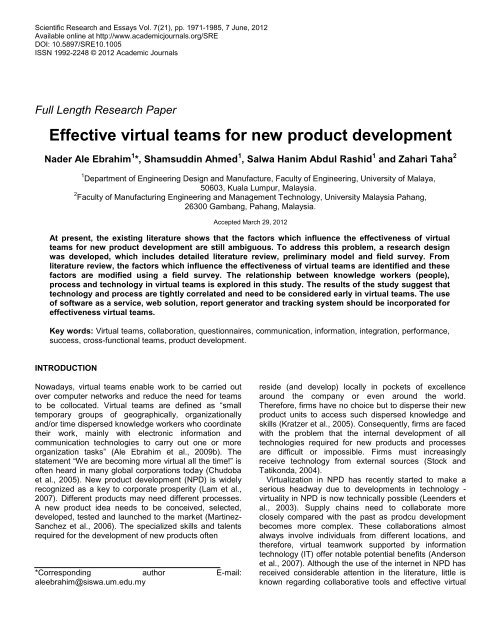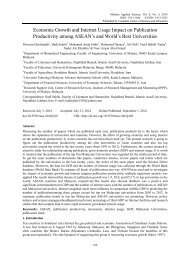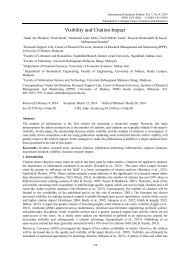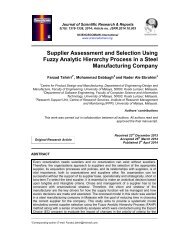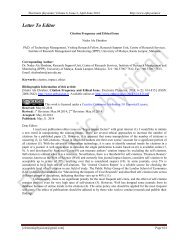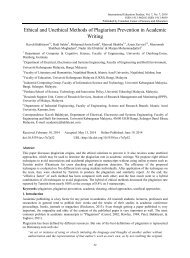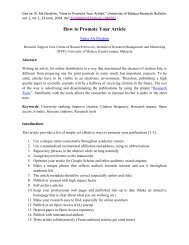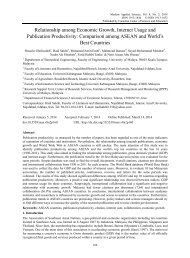Effective virtual teams for new product development
Create successful ePaper yourself
Turn your PDF publications into a flip-book with our unique Google optimized e-Paper software.
Scientific Research and Essays Vol. 7(21), pp. 1971-1985, 7 June, 2012<br />
Available online at http://www.academicjournals.org/SRE<br />
DOI: 10.5897/SRE10.1005<br />
ISSN 1992-2248 © 2012 Academic Journals<br />
Full Length Research Paper<br />
<strong>Effective</strong> <strong>virtual</strong> <strong>teams</strong> <strong>for</strong> <strong>new</strong> <strong>product</strong> <strong>development</strong><br />
Nader Ale Ebrahim 1 *, Shamsuddin Ahmed 1 , Salwa Hanim Abdul Rashid 1 and Zahari Taha 2<br />
1 Department of Engineering Design and Manufacture, Faculty of Engineering, University of Malaya,<br />
50603, Kuala Lumpur, Malaysia.<br />
2 Faculty of Manufacturing Engineering and Management Technology, University Malaysia Pahang,<br />
26300 Gambang, Pahang, Malaysia.<br />
Accepted March 29, 2012<br />
At present, the existing literature shows that the factors which influence the effectiveness of <strong>virtual</strong><br />
<strong>teams</strong> <strong>for</strong> <strong>new</strong> <strong>product</strong> <strong>development</strong> are still ambiguous. To address this problem, a research design<br />
was developed, which includes detailed literature review, preliminary model and field survey. From<br />
literature review, the factors which influence the effectiveness of <strong>virtual</strong> <strong>teams</strong> are identified and these<br />
factors are modified using a field survey. The relationship between knowledge workers (people),<br />
process and technology in <strong>virtual</strong> <strong>teams</strong> is explored in this study. The results of the study suggest that<br />
technology and process are tightly correlated and need to be considered early in <strong>virtual</strong> <strong>teams</strong>. The use<br />
of software as a service, web solution, report generator and tracking system should be incorporated <strong>for</strong><br />
effectiveness <strong>virtual</strong> <strong>teams</strong>.<br />
Key words: Virtual <strong>teams</strong>, collaboration, questionnaires, communication, in<strong>for</strong>mation, integration, per<strong>for</strong>mance,<br />
success, cross-functional <strong>teams</strong>, <strong>product</strong> <strong>development</strong>.<br />
INTRODUCTION<br />
Nowadays, <strong>virtual</strong> <strong>teams</strong> enable work to be carried out<br />
over computer networks and reduce the need <strong>for</strong> <strong>teams</strong><br />
to be collocated. Virtual <strong>teams</strong> are defined as “small<br />
temporary groups of geographically, organizationally<br />
and/or time dispersed knowledge workers who coordinate<br />
their work, mainly with electronic in<strong>for</strong>mation and<br />
communication technologies to carry out one or more<br />
organization tasks” (Ale Ebrahim et al., 2009b). The<br />
statement “We are becoming more <strong>virtual</strong> all the time!” is<br />
often heard in many global corporations today (Chudoba<br />
et al., 2005). New <strong>product</strong> <strong>development</strong> (NPD) is widely<br />
recognized as a key to corporate prosperity (Lam et al.,<br />
2007). Different <strong>product</strong>s may need different processes.<br />
A <strong>new</strong> <strong>product</strong> idea needs to be conceived, selected,<br />
developed, tested and launched to the market (Martinez-<br />
Sanchez et al., 2006). The specialized skills and talents<br />
required <strong>for</strong> the <strong>development</strong> of <strong>new</strong> <strong>product</strong>s often<br />
*Corresponding author E-mail:<br />
aleebrahim@siswa.um.edu.my<br />
reside (and develop) locally in pockets of excellence<br />
around the company or even around the world.<br />
There<strong>for</strong>e, firms have no choice but to disperse their <strong>new</strong><br />
<strong>product</strong> units to access such dispersed knowledge and<br />
skills (Kratzer et al., 2005). Consequently, firms are faced<br />
with the problem that the internal <strong>development</strong> of all<br />
technologies required <strong>for</strong> <strong>new</strong> <strong>product</strong>s and processes<br />
are difficult or impossible. Firms must increasingly<br />
receive technology from external sources (Stock and<br />
Tatikonda, 2004).<br />
Virtualization in NPD has recently started to make a<br />
serious headway due to <strong>development</strong>s in technology -<br />
<strong>virtual</strong>ity in NPD is now technically possible (Leenders et<br />
al., 2003). Supply chains need to collaborate more<br />
closely compared with the past as prodcu <strong>development</strong><br />
becomes more complex. These collaborations almost<br />
always involve individuals from different locations, and<br />
there<strong>for</strong>e, <strong>virtual</strong> teamwork supported by in<strong>for</strong>mation<br />
technology (IT) offer notable potential benefits (Anderson<br />
et al., 2007). Although the use of the internet in NPD has<br />
received considerable attention in the literature, little is<br />
known regarding collaborative tools and effective <strong>virtual</strong>
1972 Sci. Res. Essays<br />
Figure 1. Model <strong>for</strong> effective <strong>virtual</strong> teamwork (Source (Bal and<br />
Gundry, 1999)).<br />
<strong>teams</strong> <strong>for</strong> NPD (Ale Ebrahim et al., 2009a).<br />
THE NEED FOR EFFECTIVE VIRTUAL TEAMS<br />
A review of the literature reveals that the factors which<br />
influence the effectiveness of <strong>virtual</strong> <strong>teams</strong> are still<br />
ambiguous (Ale Ebrahim et al., 2009d). One of the<br />
notable challenges <strong>for</strong> effective <strong>virtual</strong> <strong>teams</strong> is ensuring<br />
good communication amongst all members of the<br />
distributed <strong>teams</strong> (Anderson et al., 2007). Jarvenpaa and<br />
Leidner (1999) found that regular and timely<br />
communication feedback is a key to building trust and<br />
commitment in distributed <strong>teams</strong>. A study by Lin et al.<br />
(2008) suggested that social dimensional factors need to<br />
be considered early during the <strong>virtual</strong> team creation<br />
process, and are critical to the effectiveness of the team.<br />
Communication is a tool that directly influences the social<br />
dimensions of the team, which improves team<br />
per<strong>for</strong>mance and has a positive impact on satisfaction<br />
within the <strong>virtual</strong> team.<br />
For <strong>teams</strong> moving from collocation to <strong>virtual</strong><br />
environments, an ability to adapt and change can be a<br />
long process riddled with trial and error scenarios. This<br />
process is seen as necessary to encourage effective<br />
<strong>virtual</strong> <strong>teams</strong> (Kirkman et al., 2002). Despite weak ties<br />
between <strong>virtual</strong> team members, ensuring lateral<br />
communication may be adequate <strong>for</strong> effective <strong>virtual</strong><br />
team per<strong>for</strong>mance. In terms of implementation, lateral<br />
communication in both <strong>virtual</strong> context and composition<br />
<strong>teams</strong> can be increased by reducing the hierarchical<br />
structure of the team (that is, a flatter reporting structure<br />
and/or decentralization) and the use of computermediated<br />
communication tools (Wong and Burton, 2000).<br />
Malhotra and Majchrzak’s (2004) study of 54 effective<br />
<strong>virtual</strong> <strong>teams</strong> found that creating a state of shared<br />
understanding about goals and objectives, task<br />
requirements and interdependencies, roles and<br />
responsibilities, and member expertise had a positive<br />
effect on output quality. Hertel et al. (2005) collected<br />
effectiveness ratings from team managers both at the<br />
individual team levels. The results of the field study<br />
showed good reliability of task work-related attributes,<br />
teamwork-related attributes, and attributes related to telecooperative<br />
work.<br />
Shachaf and Hara (2005) proposed four dimensions of<br />
effective <strong>virtual</strong> team leadership:<br />
1. Communication: the leader provides continuous<br />
feedback, engages in regular and prompt communication<br />
and clarifies tasks.<br />
2. Understanding: the leader is sensitive to the members’<br />
schedules, appreciates their opinions and suggestions,<br />
cares about their problems, gets to know them and<br />
expresses a personal interest in them.<br />
3. Role clarity: the leader clearly defines responsibilities<br />
of all members, exercises authority, and mentors <strong>virtual</strong><br />
team members.<br />
4. Leadership attitude: the leader is assertive yet not too<br />
“bossy,” caring, relates to members at their own levels,<br />
and upholds a consistent attitude over the life of the<br />
project.<br />
From observations and interviews, Bal et al. (2001b,<br />
1999) identified 12 elements <strong>for</strong> effective <strong>virtual</strong><br />
teamwork, as illustrated in Figure 1. The Bal and Gundry<br />
(2001b, 1999) model was used as the basic framework in<br />
this paper.
Ebrahim et al. 1973<br />
Table 1. Tools <strong>for</strong> <strong>virtual</strong> <strong>teams</strong>.<br />
Tool Examples Uses and Advantages Immediacy Sensory Modes<br />
Instant<br />
Messaging and<br />
Chat<br />
Groupware /<br />
Shared Services<br />
Remote Access<br />
and Control<br />
Web<br />
Conferencing<br />
File Transfer<br />
Email<br />
Telephone<br />
• Yahoo Messenger<br />
• MSN Messenger<br />
• AOL Instant<br />
Messenger<br />
• Skype<br />
• Lotus Notes<br />
• Microsoft Exchange<br />
• Novell Groupwise<br />
• NetMeeting<br />
• WebEx<br />
• Remote Desktop<br />
• pcAnywhere<br />
• NetMeeting<br />
• WebEx<br />
• Meeting Space<br />
• GoToMeeting<br />
Adopted from Thissen et al. (2007).<br />
• File Transfer Protocol<br />
(FTP)<br />
• Collaborative<br />
Websites<br />
• Intranets<br />
• Many vendors and •<br />
free applications<br />
• “Plain Old Telephone<br />
Service” (POTS)<br />
• Voice Over Internet<br />
Protocol (VOIP)<br />
• Instant interaction<br />
• Less intrusive than a phone call<br />
• View who is available<br />
• Low cost<br />
• Low setup ef<strong>for</strong>t<br />
• Calendars<br />
• Contact Lists<br />
• Arrange meetings<br />
• Cost and setup ef<strong>for</strong>t vary<br />
• User controls a PC without being<br />
on-site<br />
• Cost varies<br />
• Setup varies<br />
• Live audio<br />
• Dynamic video<br />
• Whiteboard<br />
• Application sharing<br />
• Moderate cost and setup ef<strong>for</strong>t<br />
• Share files of any type<br />
• Cost varies<br />
• Moderate setup ef<strong>for</strong>t<br />
• Send messages or files<br />
• Cost and setup ef<strong>for</strong>t vary<br />
• Direct calls<br />
• Conference calls<br />
• Cost varies<br />
• Low setup ef<strong>for</strong>t<br />
• Synchronous or<br />
asynchronous<br />
• Asynchronous<br />
• Synchronous<br />
• Synchronous<br />
• Asynchronous<br />
• Asynchronous<br />
• Synchronous<br />
• Asynchronous <strong>for</strong><br />
voice mail<br />
• Visual<br />
• Text and limited<br />
graphics<br />
• Visual<br />
• Visual<br />
• Audio<br />
• Tactile<br />
• Visual<br />
• Unlimited graphics<br />
• Optional audio<br />
• Varies with file<br />
content<br />
• Visual<br />
• Audio in attached<br />
files<br />
• Audio<br />
Virtual teamwork: Technology point of view<br />
Selection<br />
A simple transmission of in<strong>for</strong>mation from point A to point<br />
B is insufficient as the <strong>virtual</strong> environment presents<br />
significant challenges <strong>for</strong> effective communication<br />
(Walvoord et al., 2008). Being equipped with even the<br />
most advanced technology is inadequate to make a<br />
<strong>virtual</strong> team effective, since the internal group dynamics<br />
and external support mechanisms must also be present<br />
<strong>for</strong> a team to succeed in the <strong>virtual</strong> world (Lurey and<br />
Raisinghani, 2001). In<strong>for</strong>mation richness seems to be the<br />
most important criterion <strong>for</strong> technology selection and the<br />
greatest impediment to the effectiveness of <strong>virtual</strong> <strong>teams</strong><br />
is the implementation of technology (Mikkola et al., 2005).<br />
Virtual <strong>teams</strong> are technology-mediated groups of people<br />
from different disciplines that work on common tasks<br />
(Dekker et al., 2008). Hence, the way the technology is<br />
implemented appears to be a factor which makes a<br />
<strong>virtual</strong> team’s outcome more or less likely successful<br />
(Anderson et al., 2007). The matrix in Table 1 assists the<br />
<strong>virtual</strong> team facilitator in choosing the suitable technology<br />
based upon the purpose of the meeting.<br />
Location<br />
Virtual <strong>teams</strong> enable organizations to access the most<br />
qualified individuals <strong>for</strong> a particular job regardless of their<br />
locations and provide greater flexibility to individuals<br />
working from home or on the road (Bell and Kozlowski,<br />
2002). Table 2 shows the relationship between tools, time<br />
and space in <strong>virtual</strong> <strong>teams</strong>.<br />
Training<br />
Suggestions <strong>for</strong> training remote managers and <strong>virtual</strong>
1974 Sci. Res. Essays<br />
Table 2. Time /Space matrix.<br />
Same time<br />
Synchronous<br />
Same space<br />
Face-to-face meeting, Brainstorming,<br />
Vote, PC and projector Electronic white<br />
board, GDSS, Chat<br />
Different space<br />
Chat, Tele-conference, Video-conference,<br />
Liaison satellite, Audio-conference, Shared white<br />
board, Shared application<br />
Different time<br />
Asynchronous<br />
Team room, Document management<br />
system, Discussion <strong>for</strong>um, E-mail,<br />
Workflow, Project management<br />
Adapted from Bouchard and Cassivi (2004).<br />
E-mail, Workflow, Document sharing ,<br />
Discussion <strong>for</strong>um, Group agenda Cooperative hypertext and<br />
organizational memory, Version control Meeting scheduler<br />
team <strong>development</strong> can be found in (Hertel et al., 2005).<br />
The results of Anderson et al.’s (2007) systematic lab<br />
study confirmed many observations, including explicit<br />
preparation and training <strong>for</strong> <strong>virtual</strong> <strong>teams</strong> as a way of<br />
working collaboratively. In the case of computer collective<br />
efficacy, Fuller et al. (2006) indicated that computer<br />
training which is related to more advanced skills sets may<br />
be useful in building <strong>virtual</strong> team efficacy. Hertel et al.<br />
(2005) suggested that training leads to increased<br />
cohesiveness and team satisfaction.<br />
Security<br />
Since <strong>virtual</strong> teamwork involves exchanging and<br />
manipulating sensitive in<strong>for</strong>mation and data via the<br />
Internet, security is always an important issue of concern<br />
(Bal and Teo, 2001b). Team leaders should identify the<br />
special technological and security level needs of the<br />
<strong>virtual</strong> team and their team members (Hunsaker and<br />
Hunsaker, 2008).<br />
Virtual teamwork: People point of view<br />
Team selection<br />
Team selection is one of the key factors which distinguish<br />
successful <strong>teams</strong> from unsuccessful ones (Ale Ebrahim<br />
et al., 2009d). Virtual <strong>teams</strong> can be designed to include<br />
people who are most suited <strong>for</strong> a particular project (Bell<br />
and Kozlowski, 2002). In this manner, the project will be<br />
clearly defined, and the outcome priorities and supportive<br />
team climate will be established. Selection of members<br />
with the necessary skills is crucial <strong>for</strong> <strong>virtual</strong> <strong>teams</strong><br />
(Hunsaker and Hunsaker, 2008). Selection of <strong>virtual</strong> team<br />
members is particularly difficult due to the geographical<br />
and organizational separation involved (Bal and Gundry,<br />
1999).<br />
Reward structure<br />
Developing a fair and motivating reward system is<br />
another significant issue at the beginning of <strong>virtual</strong><br />
teamwork (Bal and Teo, 2001a; Hertel et al., 2005).<br />
Virtual team per<strong>for</strong>mance must be recognized and<br />
rewarded (Bal and Gundry, 1999). Lurey and Raisinghani<br />
(2001) found that reward systems ranked strongly among<br />
the external support mechanisms <strong>for</strong> <strong>virtual</strong> <strong>teams</strong> in a<br />
survey to determine the factors that contribute to the<br />
success of a <strong>virtual</strong> team.<br />
Meeting training<br />
Comparing <strong>teams</strong> with little and extensive training, Bal<br />
and Gundry (1999) noted a significant drop in<br />
per<strong>for</strong>mance as both <strong>teams</strong> went live using the system.<br />
However, the latter then improved its per<strong>for</strong>mance at a<br />
faster rate than the <strong>for</strong>mer. Training is a key aspect which<br />
cannot be neglected in team building. Virtual team<br />
members require different types of training compared to<br />
ordinary <strong>teams</strong>. The training includes self-managing<br />
skills, communication and meeting training, project<br />
management skills, technology training, et cetera (Bal<br />
and Teo, 2001b).<br />
Specify an objective<br />
While direct leadership strategies are possible in<br />
conventional <strong>teams</strong>, members of <strong>virtual</strong> <strong>teams</strong> may be<br />
managed more effectively by empowerment and by<br />
delegating managerial functions to the members (Hertel<br />
et al., 2005). Such an approach changes the role of a<br />
team manager from traditional controlling into more<br />
coaching and moderating functions (Kayworth and<br />
Leidner, 2002).<br />
Virtual team leaders should identify commonalities<br />
among members early on, while focusing the team on<br />
achieving key per<strong>for</strong>mance objectives (Ale Ebrahim et al.,<br />
2009d).<br />
Virtual teamwork: Process point of view<br />
Alignment<br />
The company’s processes need to be re-aligned with the
Ebrahim et al. 1975<br />
capabilities of <strong>virtual</strong> <strong>teams</strong>, unlike face-to-face <strong>teams</strong>.<br />
This involves an understanding of <strong>virtual</strong> team<br />
processes and existing processes (Bal and Gundry,<br />
1999). However, the key elements in knowledge sharing<br />
are hardware, software as well as the ability and<br />
willingness of team members to actively participate in the<br />
knowledge sharing process (Rosen et al., 2007).<br />
Meeting structure<br />
Proximity enables team members to engage in in<strong>for</strong>mal<br />
work (Furst et al., 2004). Virtual team members are more<br />
likely to treat one another <strong>for</strong>mally, and are less likely to<br />
reciprocate requests from one another (Wong and<br />
Burton, 2000). Shin (2005) argued that lack of physical<br />
interactions and in<strong>for</strong>mal relationships decrease the<br />
cohesiveness of <strong>virtual</strong> <strong>teams</strong>. Formal practices and<br />
routines designed to structure tasks <strong>for</strong>mally were<br />
reported to lead to higher quality output of <strong>virtual</strong> <strong>teams</strong><br />
(Massey et al., 2003). The physical absence of a <strong>for</strong>mal<br />
leader exacerbates the lack of extrinsic motivation<br />
(Kayworth and Leidner, 2002). For <strong>virtual</strong> <strong>teams</strong> which<br />
rarely meet face-to-face, team leaders often have no<br />
choice but to impose a <strong>for</strong>mal team structure.<br />
Synchronous written documents assist <strong>virtual</strong> <strong>teams</strong> to<br />
overcome challenges associated with spoken language,<br />
and this enables <strong>teams</strong> to overcome challenges<br />
associated with asynchronous and lean written<br />
communication (Shachaf, 2008).<br />
Per<strong>for</strong>mance measurement<br />
Kirkman and Rosen et al. (2004) studied the per<strong>for</strong>mance<br />
of <strong>virtual</strong> <strong>teams</strong> and showed a positive correlation<br />
between empowerment and <strong>virtual</strong> team per<strong>for</strong>mance.<br />
High-per<strong>for</strong>mance <strong>teams</strong> are differentiated by passionate<br />
dedication to goals, emotional bonding among team<br />
members and identification, and a balance between unity<br />
and respect <strong>for</strong> individual differences (Ale Ebrahim et al.,<br />
2009d).<br />
Team facilitation<br />
Team members must have crystal clear rules and<br />
responsibilities. The rule should be accountable and<br />
visible. Virtual team members may feel less accountable<br />
<strong>for</strong> results due to lack of visibility circumstances.<br />
There<strong>for</strong>e, explicit facilitation of <strong>virtual</strong> <strong>teams</strong> is of<br />
extreme importance <strong>for</strong> teamwork. Temporal coordination<br />
mechanisms such as scheduling deadlines and<br />
coordinating the pace of ef<strong>for</strong>t are recommended to<br />
increase vigilance and accountability (Massey et al.,<br />
2003).<br />
NEW PRODUCT DEVELOPMENT AND VIRTUALITY<br />
Product <strong>development</strong> is defined by different researchers<br />
in slightly different ways, but generally it is the process<br />
that covers <strong>product</strong> design, <strong>product</strong>ion system design<br />
and <strong>product</strong> introduction processes and start of<br />
<strong>product</strong>ion (Johansen, 2005). New <strong>product</strong> <strong>development</strong><br />
(NPD) has long been recognized as one of the corporate<br />
core functions (Huang et al., 2004). The rate of market<br />
and technological changes has accelerated in the past<br />
years and this turbulent environment needs <strong>new</strong> methods<br />
to bring successful <strong>new</strong> <strong>product</strong>s to the marketplace<br />
(González and Palacios, 2002). This is particularly true<br />
<strong>for</strong> companies with short <strong>product</strong> life cycles, whereby it is<br />
important to develop <strong>new</strong> <strong>product</strong>s and <strong>new</strong> <strong>product</strong><br />
plat<strong>for</strong>ms quickly and safely, which fulfill reasonable<br />
demands on quality, per<strong>for</strong>mance and cost (Ottosson,<br />
2004). The world market requires short <strong>product</strong><br />
<strong>development</strong> times (Starbek and Grum, 2002). There<strong>for</strong>e,<br />
in order to successfully and efficiently obtain all the<br />
experience needed <strong>for</strong> developing <strong>new</strong> <strong>product</strong>s and<br />
services, more and more organizations are <strong>for</strong>ced to<br />
move from traditional face-to-face <strong>teams</strong> to <strong>virtual</strong> <strong>teams</strong><br />
or adopt a combination between the two types of <strong>teams</strong><br />
(Precup et al., 2006). Given the complexities involved in<br />
organizing face-to-face interactions among team<br />
members and the advancements in electronic<br />
communication technologies, firms are turning toward<br />
employing <strong>virtual</strong> NPD <strong>teams</strong> (Badrinarayanan and<br />
Arnett, 2008; Jacobsa et al., 2005; Schmidt et al., 2001).<br />
New <strong>product</strong> <strong>development</strong> requires the collaboration of<br />
<strong>new</strong> <strong>product</strong> team members both within and outside the<br />
firm (Martinez-Sanchez et al., 2006; McDonough et al.,<br />
2001;Ozer, 2000). NPD <strong>teams</strong> are necessary in most<br />
businesses (Leenders et al., 2003). In addition, in the<br />
haste of global competition, companies faced increasing<br />
pressure to build critical mass, reach <strong>new</strong> markets and<br />
plug skill gaps. NPD ef<strong>for</strong>ts are increasingly being<br />
pursued across multiple nations through all <strong>for</strong>ms of<br />
organizational arrangements (Cummings and Teng,<br />
2003). Given the resulting differences in time zones and<br />
physical distances in such ef<strong>for</strong>ts, <strong>virtual</strong> NPD projects<br />
are receiving increasing attention (McDonough et al.,<br />
2001; Ale Ebrahim et al., 2010). The use of <strong>virtual</strong> <strong>teams</strong><br />
<strong>for</strong> <strong>new</strong> <strong>product</strong> <strong>development</strong> is rapidly growing and in<br />
which organizations can rely on to sustain competitive<br />
advantage (Taifi, 2007). Hence, <strong>virtual</strong> <strong>teams</strong> provide<br />
valuable input <strong>for</strong> <strong>new</strong> <strong>product</strong> <strong>development</strong> (Ale Ebrahim<br />
et al., 2009c).<br />
PRIMARY MODELS AND HYPOTHESES<br />
In this study, a <strong>new</strong> primary model is adapted from Bal<br />
and Gundry (2001b, 1999), with respect to the<br />
requirements of the company in determining the
1976 Sci. Res. Essays<br />
Figure 2. Preliminary model <strong>for</strong> evaluating the effectiveness of <strong>virtual</strong> <strong>teams</strong>.<br />
appropriate design tools and methods <strong>for</strong> an effective<br />
<strong>new</strong> <strong>product</strong> <strong>development</strong> in <strong>virtual</strong> <strong>teams</strong> (Figure 2).<br />
Hypotheses<br />
From a review of the existing literature, it is evident that<br />
there remains a gap with respect to the requirements of<br />
the company in determining the appropriate design tools<br />
and methods <strong>for</strong> effective <strong>new</strong> <strong>product</strong> <strong>development</strong> in<br />
<strong>virtual</strong> <strong>teams</strong>. This research proposes the following<br />
hypotheses in order to fulfill the requirements:<br />
H 1 : Technology is positively correlated to Process in<br />
<strong>virtual</strong> <strong>teams</strong>.<br />
H 2 : Technology is positively correlated to Knowledge<br />
Workers in <strong>virtual</strong> <strong>teams</strong>.<br />
H 3 : Process and Knowledge Workers are positively<br />
correlated in <strong>virtual</strong> <strong>teams</strong>.<br />
H 4 : There is an insignificant difference between the<br />
origins of <strong>virtual</strong> <strong>teams</strong>.<br />
METHODOLOGY<br />
To test the hypotheses, a Web-based survey was carried out in a<br />
random sample of small and medium enterprises in Malaysian and<br />
Iranian manufacturers. A survey is developed <strong>for</strong> data collection,<br />
whereby a Likert scale from 1 to 5 is used. This scale provides<br />
respondents with a series of attitude dimensions. For each<br />
dimension, the respondent is asked whether, and how strongly,<br />
they agree or disagree to each dimension using a point rating scale.<br />
The questionnaire is e-mailed to the Managing Director, R&D<br />
Manager, New Product Development Manager, Project and Design<br />
Manager and appropriate personnel who are most familiar with<br />
R&D activities within the firm. The rapid expansion of Internet users<br />
has given Web-based surveys the potential to become a powerful<br />
tool in survey research (Sills and Song, 2002; Ebrahim et al., 2010).<br />
The findings of Denscombe (2006) encouraged social researchers<br />
to use Web-based questionnaires with confidence. The data<br />
produced by Web-based questionnaires is equivalent to that<br />
produced by paper-based questionnaires. Other authors highlighted<br />
the data provided by Internet methods are of at least as good<br />
quality as those provided by traditional paper-and-pencil methods<br />
(Gosling et al., 2004; Deutskens et al., 2006). Invitation e-mails are<br />
sent to each respondent, reaching 1500 valid e-mail accounts, with<br />
reminders following one month later. 240 enterprises submit<br />
responses, giving an overall response rate of 12%. Table 3<br />
presents the respondents’ demographics upon deduction of missing<br />
data. The survey is limited to the sample size and population in the<br />
specified regions.<br />
RESULTS AND ANALYSIS<br />
For reliability analysis, Cronbach’s Alpha (Cronbach,<br />
1951) is employed to measure the internal consistency of<br />
each construct. A reliability test is carried out to ensure<br />
that the research findings have the ability to produce
Ebrahim et al. 1977<br />
Table 3. Frequency Distributions of Demographic Variables (N=240).<br />
Variable Frequency distribution N (%)<br />
Gender<br />
Male 202 (85.6)<br />
Female 34 (14.4)<br />
Country<br />
Iran 136 (56.7)<br />
Malaysia 74 (30.8)<br />
Others (Developing) 15 (6.2)<br />
Others (Developed) 15 (6.2)<br />
Age group<br />
Up to 21 2 (0.9)<br />
21-34 103 (44.6)<br />
35-49 101 (43.7)<br />
50-64 23 (10.0)<br />
Over 65 2 (0.9)<br />
Job Roles<br />
Managing director 51 (22.7)<br />
R&D Manager 25 (11.1)<br />
New Product Development Manager 27 (12.0)<br />
Project Manager 43 (19.1)<br />
Design manager 7 (3.1)<br />
Others 72 (32.0)<br />
Main Business<br />
Automotive/vehicle and components 89 (37.1)<br />
Electronic <strong>product</strong>s and components 30 (12.5)<br />
Fabricated metal <strong>product</strong>s 13 (5.4)<br />
Electrical machinery, apparatuses, appliances, or supplies 12 (5.0)<br />
Machinery/ Industrial equipment 9 (3.8)<br />
Home appliances 12 (5.0)<br />
Pharmaceutical or Chemical <strong>product</strong>s (including cosmetics, paints) 4 (1.7)<br />
Paper <strong>product</strong>s 4 (1.7)<br />
Plastic <strong>product</strong>s 3 (1.2)<br />
Food and Food packaging 1 (0.4)<br />
Instrumentation equipment 4 (1.7)<br />
Textile 2 (0.8)<br />
Oil and Gas 11 (4.6)<br />
Education 14 (5.8)<br />
Others 32 (13.3)<br />
consistent results. From Table 4, all items having a<br />
Cronbach’s α greater than 0.6 are included in the<br />
analysis, while the rest are omitted from the analysis. In<br />
general, the reliability of the questionnaire’s instruments<br />
is acceptable.<br />
The Bartlett’s Chi-square test of sphericity and Kaiser-<br />
Meyer-Olkin (KMO) is used to measure sampling<br />
adequacy in order to conclude whether the partial<br />
correlation of the knowledge workers and variables are<br />
small (Fathian et al., 2008). Table 5 summarizes the<br />
results of KMO, in which the value is 0.878. The<br />
significant value <strong>for</strong> Bartlett's test is less than 0.05, and<br />
the results indicate that there is good correlation.<br />
An exploratory factor analysis is per<strong>for</strong>med on eight<br />
knowledge worker factors after removing Pe1, Pe5 and<br />
Pe11, which have a Cronbach’s α of less than 0.6 using a<br />
Principle Component Analysis with a Varimax Rotation<br />
and an Eigenvalue of 1 as the cut-off point (Akgün et al.,<br />
2008) and an absolute value of a loading greater than 0.5<br />
(Fathian et al., 2008). Factor loading shows that only one<br />
component can be extracted. There<strong>for</strong>e, all eight items in<br />
knowledge workers can be grouped into a single factor.<br />
The same procedure is per<strong>for</strong>med on process and<br />
technology factors. The items and their factor loadings
Technology (N=218)<br />
Process (N=211)<br />
Knowledge worker (N=218)<br />
1978 Sci. Res. Essays<br />
Table 4. Summary of the final measures and reliabilities.<br />
Factor and<br />
variable<br />
name<br />
Items<br />
Mean*<br />
Std.<br />
Deviation<br />
Corrected<br />
Item-Total<br />
Correlation<br />
Cronbach's<br />
Alpha if Item<br />
Deleted<br />
Pe1 Working together 4.037 1.029 0.560 0.872<br />
Pe2 Interactions from inside 3.995 0.912 0.641 0.867<br />
Pe3 Interactions from outside 3.824 1.001 0.634 0.867<br />
Pe4 Interactions with colleagues 3.982 0.991 0.649 0.866<br />
Pe5 Online training and e-learning 3.401 1.143 0.597 0.87<br />
Pe6 Consulting service 3.472 0.998 0.624 0.868<br />
Pe7<br />
Collaborating and making decisions with co-workers or<br />
suppliers<br />
3.863 0.943 0.642 0.867<br />
Pe8 Facilitates cooperation between employees 3.876 0.917 0.651 0.867<br />
Pe9 Facilitates introduction of <strong>new</strong> employees 3.553 1.079 0.654 0.866<br />
Pe10 Facilitates the management of NPD project 3.706 1.014 0.654 0.866<br />
Pe11 Is used by competitors 3.106 1.238 0.301 0.893<br />
Pr1<br />
Project control (such as Intranet based project status<br />
tracking system)<br />
3.64 1.101 0.650 0.928<br />
Pr2<br />
Project reporting system (such as MS-Project reporting<br />
system)<br />
3.82 1.026 0.666 0.927<br />
Pr3 Making business together 3.648 0.943 0.627 0.928<br />
Pr4 Reduce traveling time and cost 3.862 1.024 0.722 0.925<br />
Pr5<br />
Reduce the number of working hours needed to solve the<br />
task<br />
3.827 1.008 0.725 0.925<br />
Pr6 Collaborative solutions 3.701 0.916 0.694 0.926<br />
Pr7<br />
Facilitates data collection in <strong>new</strong> <strong>product</strong> <strong>development</strong><br />
project<br />
3.813 0.952 0.744 0.924<br />
Pr8<br />
Interaction with customers <strong>for</strong> gathering <strong>new</strong> <strong>product</strong><br />
features<br />
3.83 0.973 0.674 0.926<br />
Pr9 Provide quantitative answer 3.384 0.985 0.664 0.927<br />
Pr10 Generate an easy and interpretable answer 3.333 0.981 0.642 0.927<br />
Pr11 Ease of generating reports 3.678 1.028 0.740 0.924<br />
Pr12 Ease of data entry 3.775 0.937 0.737 0.924<br />
Pr13 Ability to accommodate multiple users 3.905 1.019 0.667 0.927<br />
Te1 Use internet and electronic mail 4.202 0.986 0.528 0.945<br />
Te2 Online meeting on need basis 3.535 1.13 0.764 0.941<br />
Te3 Web conferencing 3.381 1.17 0.778 0.941<br />
Te4 Seminar on the Web 3.134 1.172 0.742 0.942<br />
Te5 Shared work spaces 3.507 1.063 0.749 0.942<br />
Te6 Video conferencing 3.172 1.161 0.737 0.942<br />
Te7 Audio conferencing 3.221 1.146 0.735 0.942<br />
Te8 Online presentations 3.453 1.107 0.809 0.941<br />
Te9 Share documents (off-line) 3.601 1.075 0.637 0.944<br />
Te10<br />
Share what’s on your computer desktop with people in<br />
other locations (in real time)<br />
3.196 1.206 0.577 0.945<br />
Te11<br />
Do not install engineering software (get service through<br />
web browser)<br />
3.179 1.211 0.590 0.945<br />
Te12 Access service from any computer (in Network) 3.542 1.041 0.688 0.943<br />
Te13 Standard phone service and hybrid services 3.576 1.07 0.511 0.946<br />
Te14 Access shared files anytime, from any computer 3.686 1.01 0.625 0.944<br />
Te15 Web database 3.649 0.995 0.704 0.943<br />
Te16 Provide instant collaboration 3.595 1.037 0.654 0.943
Ebrahim et al. 1979<br />
Table 4. Contd.<br />
Te17<br />
Software as a service (eliminating the need to install and<br />
run the application on the own computer)<br />
3.531 1.07 0.666 0.943<br />
Te18 Virtual research center <strong>for</strong> <strong>product</strong> <strong>development</strong> 3.455 1.078 0.681 0.943<br />
Te19<br />
Can be integrated/compatible with the other tools and<br />
systems<br />
3.688 1.139 0.613 0.944<br />
*Frequency values - 1: Not important; 2: Slightly important; 3: Important; 4: Quite important; 5: Extremely important.<br />
Table 5. KMO and Bartlett’s Test results.<br />
Kaiser-Meyer-Olkin Measure of Sampling Adequacy. 0. 878<br />
Approx. Chi-Square 679.744<br />
Bartlett's Test of Sphericity df 28<br />
Sig. 0.000<br />
Table 6. Factor analysis results on 13 process items.<br />
Component<br />
Initial eigenvalues<br />
Rotation sums of squared loadings<br />
Total % of Variance Cumulative % Total % of Variance Cumulative %<br />
1 7.158 55.062 55.062 4.255 32.733 32.733<br />
2 1.126 8.662 63.724 4.029 30.991 63.724<br />
3 0.951 7.314 71.039<br />
4 0.737 5.670 76.708<br />
5 0.544 4.185 80.893<br />
6 0.461 3.544 84.437<br />
7 0.445 3.422 87.859<br />
8 0.415 3.192 91.051<br />
9 0.333 2.558 93.609<br />
10 0.304 2.338 95.947<br />
11 0.222 1.707 97.654<br />
12 0.173 1.331 98.985<br />
13 0.132 1.015 100.000<br />
Extraction method: Principal Component Analysis.<br />
after Exploratory Factor Analysis, Eigenvalue, and<br />
percentage of variance, are shown in Tables 6, 7, 8 and<br />
9, respectively The 13 process items and 15 technology<br />
items are divided into two different groups, which have an<br />
Eigenvalue greater than one.<br />
The confirmed factors are then identified based on<br />
conciseness, without losing clarity of meaning. Upon<br />
extraction of the factors, the items with higher loadings<br />
are considered more important and have greater<br />
influence on the name of selected reduced factors. The<br />
names and contents of the two derived factors on<br />
process items are:<br />
1. Factor FPr1: This consists of Items Pr8 through Pr13,<br />
which are “Interact with customers <strong>for</strong> gathering <strong>new</strong><br />
<strong>product</strong> features”, “Provide quantitative answer”,<br />
“Generate an easy and interpretable answer”, “Ease of<br />
generating reports”, “Ease of data entry” and “Ability to
1980 Sci. Res. Essays<br />
Table 7. Rotated Component Matrix<br />
sorted by size <strong>for</strong> 13 process items.<br />
Component<br />
Items<br />
1 2<br />
Pr11 0.783 0.326<br />
Pr9 0.781 0.225<br />
Pr10 0.767 0.213<br />
Pr12 0.751 0.350<br />
Pr8 0.724 0.302<br />
Pr13 0.576 0.443<br />
Pr1 0.202 0.804<br />
Pr2 0.229 0.792<br />
Pr3 0.248 0.724<br />
Pr6 0.352 0.711<br />
Pr5 0.484 0.620<br />
Pr4 0.482 0.614<br />
Pr7 0.527 0.594<br />
Extraction Method: Principal Component<br />
Analysis. Rotation Method: Varimax with<br />
Kaiser Normalization.<br />
Table 7. Factor analysis results on 15 technology items.<br />
Component<br />
Initial eigenvalues<br />
Rotation sums of squared loadings<br />
Total % of Variance Cumulative % Total % of Variance Cumulative %<br />
1 8.471 56.471 56.471 5.581 37.205 37.205<br />
2 1.681 11.207 67.677 4.571 30.472 67.677<br />
3 0.902 6.011 73.688<br />
4 0.642 4.281 77.969<br />
5 0.530 3.536 81.505<br />
6 0.500 3.336 84.840<br />
7 0.406 2.709 87.550<br />
8 0.356 2.376 89.926<br />
9 0.321 2.143 92.069<br />
10 0.297 1.980 94.048<br />
11 0.252 1.678 95.726<br />
12 0.224 1.495 97.221<br />
13 0.164 1.092 98.313<br />
14 0.156 1.039 99.352<br />
15 0.097 0.648 100.000<br />
Extraction method: Principal component analysis.
Ebrahim et al. 1981<br />
Table 9. Rotated Component Matrix<br />
sorted by size <strong>for</strong> 15 technology items.<br />
Items<br />
Component<br />
1 2<br />
Te3 0.862 0.293<br />
Te7 0.846 0.232<br />
Te4 0.846 0.265<br />
Te6 0.845 0.263<br />
Te2 0.840 0.272<br />
Te8 0.793 0.388<br />
Te5 0.677 0.426<br />
Te9 0.566 0.386<br />
Te17 0.206 0.816<br />
Te15 0.292 0.764<br />
Te14 0.203 0.737<br />
Te19 0.248 0.730<br />
Te12 0.299 0.713<br />
Te18 0.384 0.687<br />
Te16 0.335 0.656<br />
Extraction Method: Principal Component<br />
Analysis. Rotation Method: Varimax with<br />
Kaiser Normalization.<br />
accommodate multiple users”, respectively. This factor is<br />
is given the name “Reports generator” due to the fact that<br />
Pr11 has the highest loading factor (0.783).<br />
2. Factor FPr2: This consists of Items Pr1 through Pr7,<br />
which are “Project control”, “Project reporting system”,<br />
“Making business together”, “Reduce traveling time and<br />
cost”, “Reduce the number of working hours need to<br />
solve the task”, “Collaborative solutions”, and “Facilitates<br />
data collection in <strong>new</strong> <strong>product</strong> <strong>development</strong> project”,<br />
respectively. Since Pr1 has the highest loading (0.804),<br />
this factor is given the name “Tracking system”.<br />
In a similar manner, the names and contents of the two<br />
derived factors based on technology items are:<br />
1. Factor FTe1: This consists of Items Te2 through Te9,<br />
which are “Online meeting”, “Web conferencing”,<br />
“Seminar on the Web”, “Shared work spaces”, “Video<br />
conferencing”, “Audio conferencing”, “Online<br />
presentations”, and “Share documents”, respectively.<br />
This factor is named “Web solution” since Te3 has the<br />
highest loading factor (0.862).<br />
2. Factor FTe2: This consists of Items Te12 and Te14 to<br />
Te19, which are “Access service from any computer (in<br />
Network)”, “Access shared files anytime, from any<br />
computer”, “Making business together”, “Web database”,<br />
“Provide instant collaboration”, “Software as a service”,<br />
“Virtual research centre <strong>for</strong> <strong>product</strong> <strong>development</strong>”, and<br />
“Can be integrated/compatible with the other tools and<br />
systems”, respectively. Since Te17 has the highest<br />
loading (0.816), this factor is named “Software as a<br />
service (SaaS)”.<br />
Analysis of Pearson’s correlations indicates a number of<br />
positive relationships among the variables. Knowledge<br />
Workers is strongly correlated to Process and<br />
Technology, respectively (Table 10). The correlations<br />
vary by country, as illustrated in Tables 11 and 12.<br />
Fisher’s Exact Test analysis support the fact that are<br />
insignificant differences (p > 0.427) between selected<br />
countries in terms of Knowledge Workers, Process and<br />
Technology in <strong>virtual</strong> <strong>teams</strong>.<br />
The mean scores <strong>for</strong> frequency of use to exchange<br />
business in<strong>for</strong>mation are illustrated in Table 11.<br />
Electronic mail is the most frequently used tool <strong>for</strong> all<br />
<strong>teams</strong> in Malaysia and Iran. Personal telephone call is<br />
the second most frequently used tool in both countries.<br />
Malaysian firms use more face-to-face interactions<br />
compared to Iranian firms. On the other hand, teambased<br />
communication technologies such as shared
1982 Sci. Res. Essays<br />
Table 8. Descriptive statistics and correlations between variables (N=240).<br />
Variable Mean Std. dev. 1 2<br />
1. Knowledge workers 36.65 13.672<br />
2. Process 42.25 17.191 0.792*<br />
3. Technology 58.72 24.153 0.773* 0.853*<br />
*Correlation is significant at the 0.01 level (2-tailed).<br />
Table 9. Descriptive statistics and correlations between variables in Iran (N=136).<br />
Variable Mean Std. dev. 1 2<br />
1. Knowledge workers 36.14 14.251<br />
2. Process 42.66 17.165 0.791*<br />
3. Technology 60.77 24.429 0.838* 0.865*<br />
*Correlation is significant at the 0.01 level (2-tailed).<br />
Table 10. Descriptive statistics and correlations between variables in Malaysia (N=74).<br />
Variable Mean Std. dev. 1 2<br />
1. Knowledge workers 38.08 12.210<br />
2. Process 42.78 16.770 0.811*<br />
3. Technology 56.95 21.301 0.684* 0.795*<br />
*Correlation is significant at the 0.01 level (2-tailed).<br />
Table 11. Hypothesis testing results.<br />
Hypotheses<br />
Correlation/P<br />
value<br />
Conclusion<br />
H 1: Technology is positively correlated to Process in <strong>virtual</strong> <strong>teams</strong>. 0.853* Supported<br />
H 2: Technology is positively correlated to Knowledge Workers in <strong>virtual</strong> <strong>teams</strong>. 0.773* Supported<br />
H 3: Process and Knowledge Workers are positively correlated in <strong>virtual</strong> <strong>teams</strong>. 0.792* Supported<br />
H 4: There is an insignificant difference between the origins of <strong>virtual</strong> <strong>teams</strong>. 0.427 ** Supported<br />
*: p < 0:01, * * : p < 0:05.<br />
database, group telephone conference, electronic<br />
whiteboard and video conference are not often used.<br />
Although video conference is used less than once a<br />
month in Iranian firms, this tool is most often used by<br />
Malaysian firms. Video conferencing may prove effective<br />
in bringing remote members together if such tool is made<br />
available to the <strong>teams</strong>, and this may be a fruitful area <strong>for</strong><br />
future research (Lurey and Raisinghani, 2001). Item Te6<br />
addresses the need <strong>for</strong> video conferencing as a tool <strong>for</strong><br />
<strong>virtual</strong> <strong>teams</strong> and a mean score of (N=218) 3.172 is<br />
attained, which indicates that this tool is essential <strong>for</strong><br />
<strong>virtual</strong> team members. This finding agrees with the<br />
recommendation by Lurey and Raisinghani (2001).<br />
The factors are summarized in Figure 3. This <strong>new</strong><br />
model is based on Bal and Gundry (1999)’s model,<br />
whereby several modifications are derived from data<br />
analysis and survey findings. The model provides an<br />
overview of effective <strong>virtual</strong> <strong>teams</strong> <strong>for</strong> <strong>new</strong> <strong>product</strong><br />
<strong>development</strong> in selected developing countries, namely,<br />
Malaysia and Iran.<br />
Research limitations and directions <strong>for</strong> future<br />
research directions<br />
The model developed <strong>for</strong> effective <strong>virtual</strong> <strong>teams</strong> is an
Ebrahim et al. 1983<br />
Table 12. Mean* scores <strong>for</strong> frequency of use <strong>for</strong> exchange business in<strong>for</strong>mation tools in Iran and<br />
Malaysia.<br />
Tools Iranian <strong>teams</strong> (N=86) Malaysian <strong>teams</strong> (N=31)<br />
E-mail 4.62 4.97<br />
Personal telephone call 4.54 4.63<br />
Fax 4.02 4.00<br />
Face-to-face interaction 3.65 4.23<br />
Shared database/groupware 3.09 2.74<br />
Meeting facilitation software 2.49 2.71<br />
Web collaborative tool 2.42 2.65<br />
Electronic <strong>new</strong>sletter 2.38 2.59<br />
Voice mail 2.32 3.00<br />
Electronic whiteboard 2.15 2.77<br />
Group telephone conference 2.09 2.76<br />
Video conference 1.85 2.43<br />
*Frequency values- 1: never; 2: once a month; 3: once a week; 4: a few times a week; 5: daily.<br />
Figure 3. New model <strong>for</strong> effectiveness of <strong>virtual</strong> <strong>teams</strong> (Correlation is significant at the 0.01<br />
level (2-tailed)).<br />
initial attempt to identify the relationships between<br />
Knowledge Workers, Process and Technology factors,<br />
which are seen to be critical factors in the literature. The<br />
literature review is carried out based primarily on<br />
published refereed journal and conference papers, and<br />
thus, a number of important studies may have been<br />
excluded from this research. There<strong>for</strong>e, it is possible that<br />
several factors which are excluded from the framework<br />
could be important <strong>for</strong> evaluation of <strong>virtual</strong> <strong>teams</strong>. The<br />
study is limited by the sample size and population. Future<br />
research is required to examine the model and verify it by<br />
a larger sample of <strong>virtual</strong> <strong>teams</strong> from different sectors<br />
since this study is constrained to the manufacturing<br />
sector. With a larger sample, it is possible to compare the
1984 Sci. Res. Essays<br />
results between countries more precisely. Twelve crucial<br />
factors have been identified in this research to move<br />
<strong>for</strong>ward from conventional teamwork to successful <strong>virtual</strong><br />
teamwork in <strong>new</strong> <strong>product</strong> <strong>development</strong>.<br />
Conclusions<br />
This paper is comprises of a literature review and field<br />
survey to identify the key factors which should be<br />
considered to create effective <strong>virtual</strong> <strong>teams</strong>. The findings<br />
provide a useful insight into how <strong>virtual</strong> team efficacy is<br />
<strong>for</strong>med and what its consequences are in the context of<br />
<strong>virtual</strong> <strong>teams</strong>. The results of the study indicate that<br />
Technology and Process are tightly correlated and need<br />
to be considered early in <strong>virtual</strong> <strong>teams</strong>. It is found that the<br />
role of Knowledge Workers in <strong>virtual</strong> <strong>teams</strong> is significant,<br />
which agrees well with the findings of Bal and Teo<br />
(2001b) and Ale Ebrahim et al. (2009d). The survey<br />
results reveal that all eight items in the Knowledge<br />
Workers factor remained while the remaining items are<br />
reduced into two main factors. Future research is needed<br />
to investigate the individual effects of Knowledge<br />
Workers, Technology and Process on <strong>virtual</strong> team<br />
effectiveness. “Software as a service”, “Web solution”,<br />
“Report Generator” and “Tracking system in effective<br />
<strong>virtual</strong> <strong>teams</strong>” should be taken into account in future<br />
research. E-mail is the most frequently used tool <strong>for</strong> all<br />
<strong>teams</strong> in Malaysia and Iran and there<strong>for</strong>e, managers of<br />
<strong>virtual</strong> <strong>teams</strong> should provide enhanced infrastructures <strong>for</strong><br />
effective communications between team members.<br />
Future research is essential to develop a<br />
comprehensive study which combines survey and case<br />
studies in companies of different sizes (e.g. multinational<br />
companies, and small and medium enterprises) and<br />
various types of activities (<strong>for</strong> example, research and<br />
<strong>development</strong> and <strong>new</strong> <strong>product</strong> <strong>development</strong>). Such a<br />
study is crucial to further develop the model and verify<br />
such a model using a larger sample of <strong>virtual</strong> <strong>teams</strong> from<br />
different sectors. With a larger sample, it is possible to<br />
compare the results between countries more precisely.<br />
REFERENCES<br />
Akgün AE, Dayan M,Benedetto AD (2008). New <strong>product</strong> <strong>development</strong><br />
team intelligence: Anteced. consequences Inf. Manag., 45(4): 221-<br />
226.<br />
Ale Ebrahim N, Ahmed S,Taha Z (2009a). Modified Stage-Gate: A<br />
Conceptual Model of Virtual Product Development Process. Afr. J.<br />
Mark. Manag., 1(9): 211-219.<br />
Ale Ebrahim N, Ahmed S,Taha Z (2009b). Virtual R&D <strong>teams</strong> in small<br />
and medium enterprises: A literature review. Sci. Res. Essays, 4(13):<br />
1575-1590.<br />
Ale Ebrahim N, Ahmed S,Taha Z (2009c). Virtual Teams <strong>for</strong> New<br />
Product Development – An Innovative Experience <strong>for</strong> R&D<br />
Engineers. Eur. J. Educ. Stud., 1(3): 109-123.<br />
Ale Ebrahim N, Ahmed S,Taha Z (2009d). Virtual Teams: a Literature<br />
Review. Aust. J. Basic Appl. Sci., 3(3): 2653-2669.<br />
Ale Ebrahim N, Ahmed S, Taha Z (2010). Critical Factors <strong>for</strong> New<br />
Product Developments in SMEs Virtual Team. Afr. J. Bus. Manag.,<br />
4(11): 2247-2257.<br />
Anderson AH, Mcewan R, Bal J,Carletta J (2007). Virtual team<br />
meetings: An analysis of communication and context. Comput. Hum.<br />
Behav., 23: 2558-2580.<br />
Badrinarayanan V,Arnett DB (2008). <strong>Effective</strong> <strong>virtual</strong> <strong>new</strong> <strong>product</strong><br />
<strong>development</strong> <strong>teams</strong>: an integrated framework. J. Bus. Ind. Mark,<br />
23(4): 242-248.<br />
Bal J,Gundry J (1999). Virtual teaming in the automotive supply chain.<br />
Team Per<strong>for</strong>m. Manag., 5(6): 174-193.<br />
Bal J,Teo PK (2001a). Implementing <strong>virtual</strong> teamworking: Part 2 - a<br />
literature review. Logist. Inf. Manag., 14(3): 208-222.<br />
Bal J,Teo PK (2001b). Implementing <strong>virtual</strong> teamworking: Part 3 – a<br />
methodology <strong>for</strong> introducing <strong>virtual</strong> teamworking. Logist. Inf. Manag.,<br />
14(4): 276-292.<br />
Bell BS,Kozlowski SWJ (2002). A Typology of Virtual Teams:<br />
Implications <strong>for</strong> <strong>Effective</strong> Leadership. Group Organ. Manag., 27(1):<br />
14-49.<br />
Bouchard L,Cassivi L (2004). Assessment of a Web-groupware<br />
technology <strong>for</strong> <strong>virtual</strong> <strong>teams</strong>. IAMOT 2004. Washington, D.C.<br />
Chudoba KM, Wynn E, Lu M, Watson-Manheim,Beth M (2005). How<br />
<strong>virtual</strong> are we? Measuring <strong>virtual</strong>ity and understanding its impact in a<br />
global organization. Inf. Syst. J., 15(4): 279-306.<br />
Cronbach L (1951). Coefficient alpha and the internal structure of tests.<br />
Psychometrika., 16(3): 297-334.<br />
Cummings JL,Teng BS (2003). Transferring R&D knowledge: the key<br />
factors affecting knowledge transfer success. J. Eng. Tech. Manag.,<br />
20(1): 39-68.<br />
Dekker DM, Rutte CG,Van Den Berg PT (2008). Cultural differences in<br />
the perception of critical interaction behaviors in global <strong>virtual</strong> <strong>teams</strong>.<br />
Int. J. Intercult. Rel., 32(5): 441-452.<br />
Denscombe M (2006). Web-Based Questionnaires and the Mode Effect:<br />
An Evaluation Based on Completion Rates and Data Contents of<br />
Near-Identical Questionnaires Delivered in Different Modes. Soc. Sci.<br />
Comput. Rev., 24(2): 246-254.<br />
Deutskens E, De Ruyter K,Wetzels M (2006). An assessment of<br />
equivalence between online and mail surveys in service research. J.<br />
Serv. Res., 8(4): 346-355.<br />
Ebrahim NA, Ahmed S,Taha Z (2010). Virtual R&D <strong>teams</strong> and SMEs<br />
growth: A comparative study between Iranian and Malaysian SMEs.<br />
Afr. J. Bus. Manag., 4(11): 2368-2379.<br />
Fathian M, Akhavan P,Hoorali M (2008). E-readiness assessment of<br />
non-profit ICT SMEs in a developing country: The case of Iran.<br />
Technovation., 28(9): 578-590.<br />
Fuller MA, Hardin AM,Davison RM (2006). Efficacy in Technology-<br />
Mediated Distributed Team. J. Manag. Inf. Syst., 23(3): 209-235.<br />
Furst SA, Reeves M, Rosen B,Blackburn RS (2004). Managing the life<br />
cycle of <strong>virtual</strong> <strong>teams</strong>. Acad. Manag. Exec., 18(2): 6-20.<br />
González FJM,Palacios TMB (2002). The effect of <strong>new</strong> <strong>product</strong><br />
<strong>development</strong> techniques on <strong>new</strong> <strong>product</strong> success in Spanish firms.<br />
Ind. Market. Manag., 31(3): 261-271.<br />
Gosling SD, Vazire S, Srivastava S,John OP (2004). Should We Trust<br />
Web-Based Studies? A Comparative Analysis of Six Preconceptions<br />
About Internet Questionnaires. Am. Psychol., 59(2): 93-104.<br />
Hertel GT, Geister S,Konradt U (2005). Managing <strong>virtual</strong> <strong>teams</strong>: A<br />
review of current empirical research. Hum. Resour. Manag. R., 15:<br />
69-95.<br />
Huang X, Soutar GN,Brown A (2004). Measuring <strong>new</strong> <strong>product</strong> success:<br />
an empirical investigation of Australian SMEs. Ind. Market. Manag.,<br />
33:117-123.<br />
Hunsaker PL,Hunsaker JS (2008). Virtual <strong>teams</strong>: a leader's guide.<br />
Team Per<strong>for</strong>m. Manag., 14(1/2): 86-101.<br />
Jacobsa J, Moll JV, Krause P, Kusters R, Trienekens J,Brombacher A<br />
(2005). Exploring defect causes in <strong>product</strong>s developed by <strong>virtual</strong><br />
<strong>teams</strong>. In<strong>for</strong>m. Software. Tech., 47(6): 399-410.<br />
Jarvenpaa SL,Leidner DE (1999). Communication and Trust in Global<br />
Virtual Teams. Organ. Sci., 10(6): 791-815<br />
Johansen K (2005). Collaborative Product Introduction within Extended<br />
Enterprises. PhD, Linköpings Universitet.<br />
Kayworth TR,Leidner DE (2002). Leadership <strong>Effective</strong>ness in Global<br />
Virtual Teams. Manag. Inf. Syst., 18(3): 7-40.
Ebrahim et al. 1985<br />
Kirkman BL, Rosen B, Gibson CB, Tesluk PE,Mcpherson SO (2002).<br />
Five challenges to <strong>virtual</strong> team success: lessons from Sabre Inc.<br />
Acad. Manag. Exec., 16(3): 67-79.<br />
Kirkman BL, Rosen B, Tesluk PE,Gibson CB (2004). The Impact of<br />
Team Empowerment on Virtual Team Per<strong>for</strong>mance: the Moderating<br />
Role oF Face-To-Face Interaction. Acad. Manag. J., 47(2): 175-192.<br />
Kratzer J, Leenders R,Engelen JV (2005). Keeping Virtual R&D Teams<br />
Creative. Res. Technol. Manag., 1:13-16.<br />
Lam P-K, Chin K-S, Yang J-B,Liang W (2007). Self-assessment of<br />
conflict management in client-supplier collaborative <strong>new</strong> <strong>product</strong><br />
<strong>development</strong>. Ind. Manag. Data Syst., 107(5): 688-714.<br />
Leenders RTaJ, Engelen JMLV,Kratzer J (2003). Virtuality,<br />
communication, and <strong>new</strong> <strong>product</strong> team creativity: a social network<br />
perspective. J. Eng. Technol. Manage., 20: 69-92.<br />
Lin C, Standing C,Liu Y-C (2008). A model to develop effective <strong>virtual</strong><br />
<strong>teams</strong>. Decis. Support. Syst., 45(4): 1031-1045.<br />
Lurey JS,Raisinghani MS (2001). An empirical study of best practices in<br />
<strong>virtual</strong> <strong>teams</strong>. Inf. Manag., 38(8): 523-544.<br />
Malhotra A,Majchrzak A (2004). Enabling knowledge creation in farflung<br />
<strong>teams</strong>: best practices <strong>for</strong> IT support and knowledge sharing. J.<br />
Knowl. Manag., 8(4): 75 - 88.<br />
Martinez-Sanchez A, Pérez-Pérez M, De-Luis-Carnicer P,Vela-Jiménez<br />
MJ (2006). Teleworking and <strong>new</strong> <strong>product</strong> <strong>development</strong>. Eur. J.<br />
Innovat. Manag., 9(2): 202-214.<br />
Massey AP, Montoya-Weiss MM,Yu-Ting H (2003). Because Time<br />
Matters: Temporal Coordination in Global Virtual Project Teams. J.<br />
Manag. Inf. Syst., 19(4): 129-155.<br />
Mcdonough EF, Kahn KB,Barczak G (2001). An investigation of the use<br />
of global, <strong>virtual</strong>, and collocated <strong>new</strong> <strong>product</strong> <strong>development</strong> <strong>teams</strong>. J.<br />
Prod. Innovat. Manag., 18(2): 110-120.<br />
Mikkola JH, Maclaran P,Wright S (2005). Book reviews. R&D. Manag.,<br />
35(1): 104-109.<br />
Ottosson S (2004). Dynamic <strong>product</strong> <strong>development</strong> -- DPD.<br />
Technovation., 24(3): 207-217.<br />
Ozer M (2000). In<strong>for</strong>mation Technology and New Product Development<br />
Opportunities and Pitfalls. Ind. Market. Manag., 29(5): 387-396.<br />
Precup L, O'sullivan D, Cormican K,Dooley L (2006). Virtual team<br />
environment <strong>for</strong> collaborative research projects. Int. J. Innov. Learn.,<br />
3(1): 77 - 94<br />
Rosen B, Furst S,Blackburn R (2007). Overcoming Barriers to<br />
Knowledge Sharing in Virtual Teams. Organ. Dyn., 36(3): 259-273.<br />
Schmidt JB, Montoya-Weiss MM,Massey AP (2001). New <strong>product</strong><br />
<strong>development</strong> decision-making effectiveness: Comparing individuals,<br />
face-to-face <strong>teams</strong>, and <strong>virtual</strong> <strong>teams</strong>. Decis. Sci., 32(4): 1-26.<br />
Shachaf P (2008). Cultural diversity and in<strong>for</strong>mation and communication<br />
technology impacts on global <strong>virtual</strong> <strong>teams</strong>: An exploratory study. Inf.<br />
Manag., 45(2): 131-142.<br />
Shachaf P,Hara N (2005). Team <strong>Effective</strong>ness in Virtual Environments:<br />
An Ecological Approach. In: FERRIS PAG, S., (ed.) Teaching and<br />
Learning with Virtual Teams. Idea Group Publishing.<br />
Shin Y (2005). Conflict Resolution in Virtual Teams. Organ. Dyn., 34(4):<br />
331-345.<br />
Sills SJ,Song C (2002). Innovations in Survey Research: An Application<br />
of Web-Based Surveys. Soc. Sci. Comput. Rev., 20(1): 22-30.<br />
Starbek M,Grum J (2002). Concurrent engineering in small companies.<br />
Int. J. Mach. Tool. Man., 42(3): 417-426.<br />
Stock GN,Tatikonda MV (2004). External technology integration in<br />
<strong>product</strong> and process <strong>development</strong>. Int. J. Oper. Prod. Man., 24(7):<br />
642-665.<br />
Taifi N (2007). Organizational Collaborative Model of Small and Medium<br />
Enterprises in the Extended Enterprise Era: Lessons to Learn from a<br />
Large Automotive Company and its dealers’ Network. Proceedings of<br />
the 2nd PROLEARN Doctoral Consortium on Technology Enhanced<br />
Learning, in the 2nd European Conference on Technology Enhanced<br />
Learning. Crete, Greece: CEUR Workshop Proceedings.<br />
Thissen MR, Jean MP, Madhavi CB,Toyia LA (2007). Communication<br />
tools <strong>for</strong> distributed software <strong>development</strong> <strong>teams</strong>. Proceedings of the<br />
2007 ACM SIGMIS CPR conference on Computer personnel<br />
research: The global in<strong>for</strong>mation technology work<strong>for</strong>ce. St. Louis,<br />
Missouri, USA: ACM.<br />
Walvoord AaG, Redden ER, Elliott LR,Coovert MD (2008). Empowering<br />
followers in <strong>virtual</strong> <strong>teams</strong>: Guiding principles from theory and practice.<br />
Comput. Hum. Behav., 24(5): 1884-1906.<br />
Wong SS,Burton RM (2000). Virtual Teams: What are their<br />
Characteristics, and Impact on Team Per<strong>for</strong>mance? Comput. Math.<br />
Organ. Theor., 6(4): 339-360.


